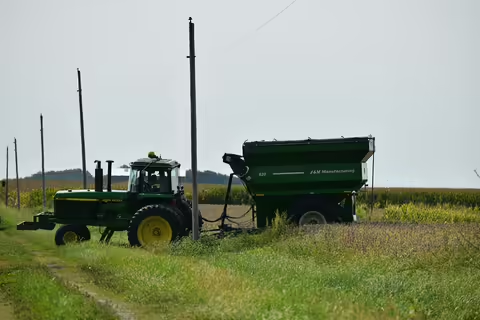SPRINGFIELD, Ill. – Fall harvest is a busy time for farmers, but safety, especially around electrical hazards, should always be a priority.
Modern farming equipment is larger than in the past and it helps farmers and workers cover more ground in less time. However, an expansive reach and height can put farm equipment too close to power lines.
“Overhead power lines often fade into the landscape, since we are so used to seeing them,” says Erin Hollinshead, executive director of Safe Electricity. “During harvest, as well as year-round, precautions are needed around power sources that include overhead and underground power lines, since once the electrical path is broken, stray electricity can cause serious injury or death.”
Farm workers should keep an eye out for low-hanging lines when entering or leaving a field and at end rows and learn how to respond if their equipment contacts an overhead line.
Electrical safety should be included in regular safety briefings. Everyone on a farm including seasonal workers, family members and truck drivers should be aware of potential electrical hazards.
If farmers are concerned about power line clearance on their farm and surrounding roadways, they should contact their electric utility. If a line is sagging, call the utility provider. Do not try to move a power line out of the way or raise it for clearance.
Safe Electricity advises the following safety guidelines:
- Inspect the height of the farm equipment to determine clearance.
- Use a spotter when operating large machinery near power lines.
- Access a grain bin from the side without a power line or pole.
- Keep equipment at least 10 feet away from power lines.
- Lower extensions to the lowest setting when moving loads.
If equipment hits a power line, remain inside the cab unless there is smoke or fire. A downed powerline can electrify equipment, the cab, and the ground, or anything else in the area. Call 911, warn others to stay away, and wait for the utility crew to cut the power.
To exit the cab safely, stand or crouch on a cap step and jump to the ground keeping both feet together. Do not make contact with the cab. Hop at least 50 feet away, keeping both feet together and touching the ground at the same time. Hopping decreases the chances of stepping from one voltage to another, which can create an electrical path through the body causing severe burns, shock and electrocution.
For more information about safety around electricity, visit SafeElectricity.org.
SOURCE: Erin Hollinshead, executive director of Safe Electricity.
WRITER: Ann Augspurger, Communications Director, Safe Electricity
Safe Electricity is the award-winning, public awareness program of the Energy Education Council, a 501(c) 3 (not-for-profit organization) established in 1952 on the campus of the University of Illinois at Urbana-Champaign. With offices located in Springfield, Ill., Safe Electricity operates under the University of Illinois Extension and is led by the EEC Board of Directors. Since the Safe Electricity program was created in 2001, it has provided thousands of safety-minded resources to its more than 500 utility members from across the country to help save lives and reduce injuries.
PHOTO ACCESS: The photo in this article and related photos are available to download for media use.
